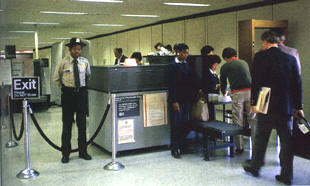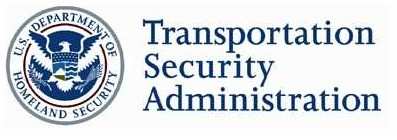Prototype Program Now Underway At BWI
 They're here to help... no, really.
On Monday, the Department of Homeland Security unveiled
improvements aimed at strengthening aviation security while
decreasing the hassle factor for travelers.
They're here to help... no, really.
On Monday, the Department of Homeland Security unveiled
improvements aimed at strengthening aviation security while
decreasing the hassle factor for travelers.
Among the key improvements, DHS is providing airlines more
flexibility to allow passengers to check in remotely who have been
unable to do so because they have a name similar to someone on a
watch list. The department also unveiled the Checkpoint Evolution
prototype, which began full operation at Baltimore-Washington
International Airport (BWI).
Each airline will now be able to create a system to verify and
securely store a passenger’s date of birth to clear up watch
list misidentifications. By voluntarily providing this limited
biographical data to an airline and verifying that information once
at the ticket counter, travelers that were previously
inconvenienced on every trip will now be able to check-in online or
at remote kiosks.
"Hassles due to misidentification and the resulting necessity to
stand in line to check in at the ticket counter is consistently
among the deepest -- and most valid -- complaints of the traveling
public," said Homeland Security Secretary Michael Chertoff.
"Thousands of passengers are inconvenienced each day, and this
change should provide a way to eliminate the vast majority of these
situations. This is good for travelers and for security, because as
we make the checkpoint environment calmer, it becomes easier to
spot individuals with hostile intent."
Chertoff cited one airline that reported "roughly 9,000 false
positives in a day," though he declined to name the carrier. "I
want to emphasize that because it will be the passenger working
directly with the airline, the government will not be acquiring the
information," he added, reports The Associated Press. "This is a
totally private process."
DHS also clarified the types of identification that will be
accepted at checkpoints in the US. Beginning May 26, 2008, federal
or state-issued photo ID will be accepted if it contains: name,
date of birth, gender, expiration date and a tamper-resistant
feature. DHS believes standardizing the list of accepted documents
will align TSA screening standards with other DHS components and
so-called "REAL ID" benchmarks.
The purpose of the new standards, and the Checkpoint Evolution
prototype, is "to calm the checkpoint," DHS notes. The BWI
prototype includes Millimeter Wave technology used in random
continuous use, multi-view X-ray and liquid bottle scanners. These
technologies, in conjunction with changes to the checkpoint
environment and processes, will be evaluated for operational
efficiency over the coming months... and, hopefully, will reduce
the need for screeners to pull bags for secondary screening.

Transportation Security Officers and managers at BWI are the
first in the country to complete a 16-hour training program
designed to incorporate the latest intelligence analysis, more
advanced explosives detection skills, and ways to engage with
passengers to promote a calmer environment for better security. The
training was developed by the Transportation Security
Administration (TSA) Office of Intelligence, Bomb Appraisal
Officers, and TSA Checkpoint Evolution team.
Checkpoint Evolution is located at B Checkpoint, Southwest
Terminal at BWI. The layered security elements are both modular and
flexible and designed to work individually, as well as part of an
integrated package.
 ANN's Daily Aero-Term (07.10.25): Performance-Based Navigation (PBN) [ICAO]
ANN's Daily Aero-Term (07.10.25): Performance-Based Navigation (PBN) [ICAO] NTSB Prelim: Cessna 172
NTSB Prelim: Cessna 172 ANN's Daily Aero-Linx (07.10.25)
ANN's Daily Aero-Linx (07.10.25) Classic Aero-TV: The Big Business of Diminutive Powerplants
Classic Aero-TV: The Big Business of Diminutive Powerplants Airborne 07.11.25: New FAA Bos, New NASA Boss (Kinda), WB57s Over TX
Airborne 07.11.25: New FAA Bos, New NASA Boss (Kinda), WB57s Over TX




